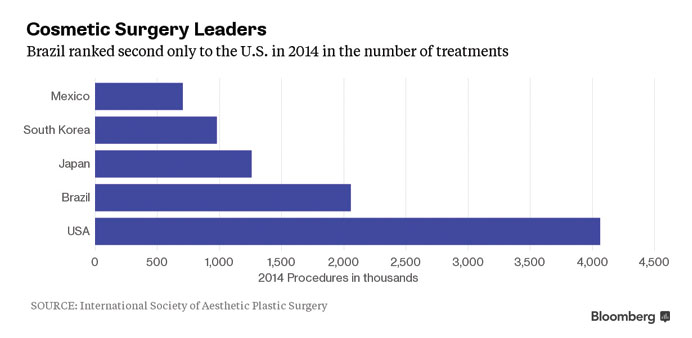Bloomberg
Sao Paulo
Danniella Gomes is about to head home to Brasilia from Texas to get some facial hair zapped and skin stains lightened, and perhaps have a tummy tuck. Even with airfare, she expects to pay much less than in the US
“I look like a man with a moustache and a beard, it’s awful,’’ Gomes, 32, said by phone from Dallas, where she’s polishing her English to resume a career as a math teacher. “Here, it’s very expensive and the quality’s not as good.’’
From buttocks enhancement to wrinkle reduction, Brazilian cosmetic surgery is becoming a bargain for visitors as the real collapses against the US dollar. Gomes is part of a growing number of medical tourists taking advantage of the bargains, a rare commercial bright spot in a country facing the worst recession in nine decades as well as a political crisis.
A $500 skin treatment in Dallas runs only about $25, or 100 reais, in Brazil, according to Gomes, whose pending trip will be her third this year for a beauty touch-up. Four hair-removal sessions in Brasilia will cost 300 reais, barely one-tenth as much as single full-face US treatment.
Cosmetic procedures are a big industry in Brazil, where last year’s total of 2.1mn was only to the 4.1mn in the US. The real’s 41% plunge against the dollar in the past 12 months means Brazilian expertise also now comes at a discount.
“With the dollar where it is right now, we’re expecting 20 people a month’’ from abroad, said Michael Boeckle, chief executive officer of Cosmetic Vacations, a decade-old company specialising in setting up foreigners with Brazilian physicians and providing transportation and nurses.
Cosmetic Vacations almost closed before the real’s recent plunge. The Brazilian currency’s strength at the time had slowed business to one or two patients a year, from a peak of 10 a month. “Now we’re hiring again,” Boeckle said.
The US may lose as much as $446.7mn in spending this year by Americans going abroad for medical services including cosmetic surgeries, the World Health Organisation said. Travellers are making up for a decrease in domestic business as Brazilians cut back on non-essential spending in the face of inflation that’s nearing 10% and rising unemployment.
One of the most common procedures travellers seek is buttock augmentation, which can cost about half what is charged in the US, Boeckle said. Brazil led the world in the surgery last year with 50,789, more than double the US’s 19,350, according to the International Society of Aesthetic Plastic Surgery.
As for domestic clients, physicians and clinics are struggling to keep prices low enough to attract Brazilians because many of products used in the beauty treatments are imported, making them more expensive with the real’s decline.
Reinaldo Tovo Filho, a physician who is president of the Brazilian Dermatology Academy-Sao Paulo, says he’s seen a 40% drop in locals coming in for minimally invasive procedures including wrinkle-correcting injections.
“The labs that produce these products are trying to keep prices as stable as possible, but I’m not sure how long that will last,’’ Tovo said.
Allergan Brasil, the local supplier of Allergan’s wrinkle-treatment Botox, is among those feeling the strain.
“Our financial planning allows us to handle currency fluctuations,” said Antonio Nasser, general manager of Allergan Brazil, by e-mail. “This isn’t an ideal situation, since our internal costs are up.”
So far, the company is still meeting sales targets, Nasser said.
Facial-filler maker Galderma, owned by Nestle’s Nestle Skin Health, is building a 200mn-real, 16,000-square-meter (19,000-square-yard) factory in Sao Paulo state that will make its products locally to help counter currency fluctuations. The plant is set to open in two years.
“There is a crisis, but growth continues to be very, very big for us,’’ Nestle Skin Health CEO Humberto Antunes said in an interview in Sao Paulo. While potential growth in Brazil is in the “thousands of percent” in part because of an aging population, Brazil fell behind China as Nestle Skin Health’s second-biggest market this year, he said.
Service providers also are trying to keep business coming in by offering instalment plans, said Edileia Bagatin, a doctor at the Brazilian dermatological society. And physicians catering to the wealthier segments of Brazil are doing fine, she said.
“These things were always expensive, and therefore geared to a public that has the extra money to spend,’’ Bagatin said.
As far as foreigners taking advantage of the now-cheaper beauty treatments, it’s not just airline passengers who are coming into doctors’ offices, said Tovo, the dermatology association physician.
“I’ve been seeing more patients from United and American airlines,’’ Tovo said. Pilots and flight attendants like to look good as well.

